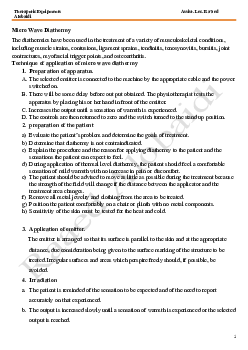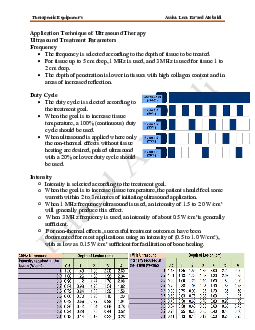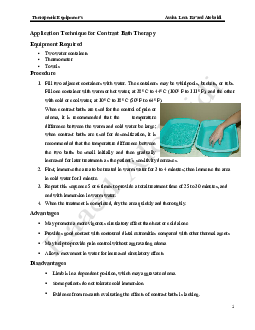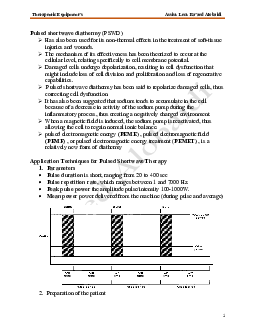

Preview text:
lOMoARcPSD|36041561
Theraputic Equipments Assist. Lec. Ra’aed Alobaidi Micro Wave Diathermy
The diathermies have been used in the treatment of a variety of musculoskeletal conditions,
including muscle strains, contusions, ligament sprains, tendinitis, tenosynovitis, bursitis, joint
contractures, myofascial trigger points, and osteoarthritis.
Technique of application of micro wave diathermy
1. Preparation of apparatus.
A. The selected emitter is connected to the machine by the appropriate cable and the power switched on.
B. There will be some delay before out put obtained. The physiotherapist tests the
apparatus by placing his or her hand in front of the emitter.
C. Increases the output until a sensation of warmth is experienced.
D. The controls are then returned to zero and the switch turned to the stand up position.
2. preparation of the patient
a) Evaluate the patient’s problem and determine the goals of treatment.
b) Determine that diathermy is not contraindicated.
c) Explain the procedure and the reason for applying diathermy to the patient and the
sensations the patient can expect to feel.
d) During application of thermal level diathermy, the patient should feel a comfortable
sensation of mild warmth with no increase in pain or discomfort.
e) The patient should be advised to move as little as possible during the treatment because
the strength of the field will change if the distance between the applicator and the treatment area changes.
f) Remove all metal jewelry and clothing from the area to be treated.
g) Position the patient comfortably on a chair or plinth with no metal components.
h) Sensitivity of the skin must be tested for the heat and cold.
3. Application of emitter.
The emitter is arranged so that its surface is parallel to the skin and at the appropriate Raaed Alobaidi
distance, due consideration being given to the surface marking of the structure to be
treated. Irregular surfaces and areas which perspire freely should, if possible, be avoided. 4. Irradiation
a. The patient is reminded of the sensation to be expected and of the need to report
accurately on that experienced.
b. The output is increased slowly until a sensation of warmth is experienced or the selected output is reached. 1
Downloaded by Nga T??ng (ngahuong55@gmail.com) lOMoARcPSD|36041561
Theraputic Equipments Assist. Lec. Ra’aed Alobaidi
c. The irradiation continues for an appropriate time.
d. The physiotherapist visiting the patient frequently to ensure that nothing untoward has occurred.
e. Slight erythema may be observed, but there should be no marked skin reaction.
f. When the treatment is complete, turn off the device, remove the applicator , and inspect
the treatment area. It is normal for the area to appear slightly red, and it may also feel warm to the touch. 5. Dosage
a) The dosage can be calculated from the power output of the machine, which may be up to 200 watts.
b) In all cases the sensation experienced by the patient must by primary guide when giving doses.
c) As a general rule, weaker doses should be used for acute than for chronic conditions.
d) The duration of irradiation ranges from 10 to 30 minutes.
e) It s advisable to commence cautiously and in all cases progressive increases in exposure
must depend on the patients reaction.
f) Treatment may be given daily or on alternate days. Raaed Alobaidi 2
Downloaded by Nga T??ng (ngahuong55@gmail.com)



